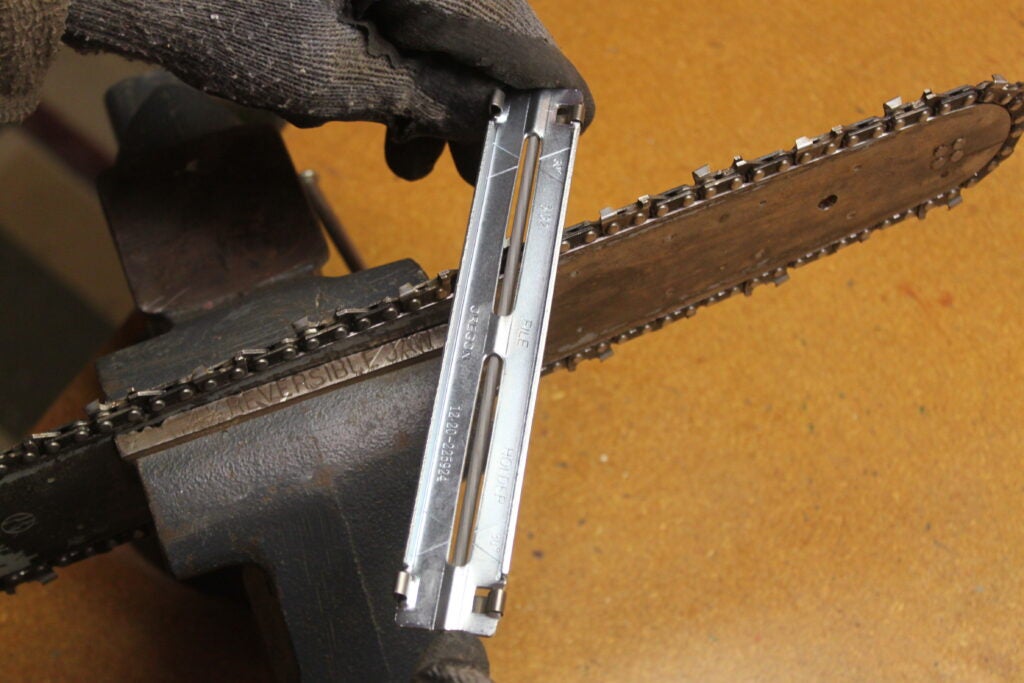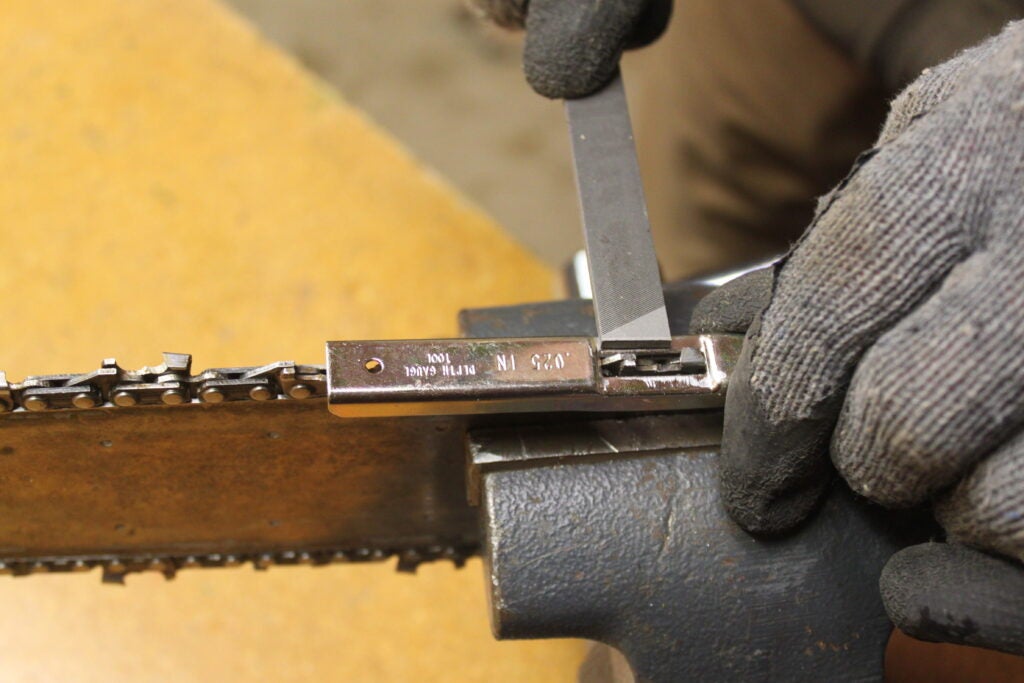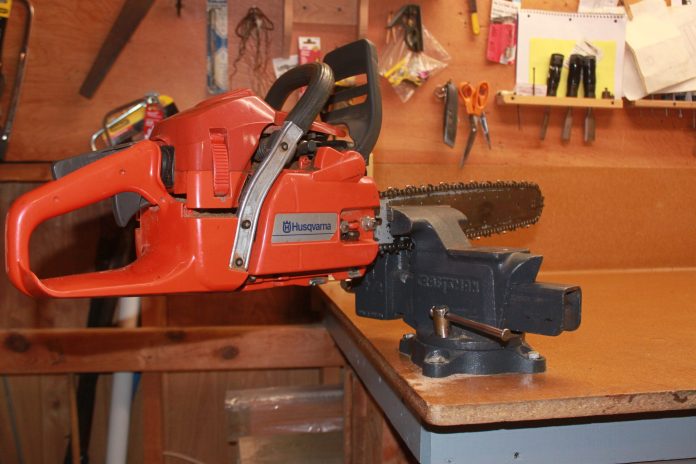We may earn revenue from the products available on this page and participate in affiliate programs. Learn more ›
If you’ve run a chainsaw, you’ve experienced it. The same machine that buzzed through firewood or felled a tree with ease suddenly turns into little more than a noisemaker. You can press those teeth against the wood as hard as you want, but progress–if it comes as all–is agonizingly slow. Assuming your blade is still making revolutions on the bar, there’s only one conclusion: Your blade is dull. But if you know how to sharpen a chainsaw, it’s an easy fix.
Lots of things can make a chainsaw dull. Hours spent on hardwood species like oak or hickory simply wear on the teeth and make them lose their edge. But slice through any chunk of firewood and hit dirt or a rock, and your blade can go from sharp to ineffective in a second.
The good news is there’s no secret to sharpening a chainsaw, and the process is not that hard. With the right tools and a little practice, you can turn that butter knife into a cutting machine in just a few minutes. Read along to learn how to sharpen a chainsaw chain, and keep that edge properly maintained.
How to Sharpen a Chainsaw
In the most basic sense, sharpening a chainsaw can be done manually or with an electric sharpener. Both methods achieve the same goal of putting a fresh edge on the cutting teeth and aligning the chain’s rakers to a proper height. You’ll need special gauges, guides, and files to sharpen your saw blade at the proper angles, but these tools are generally pretty affordable. Here’s a step-by-step guide below on how to sharpen a chainsaw
Table of Contents
- Clean it up
- How to Sharpen a Chainsaw with a File
- Non-Manual Options
- Keeping It Up
- Frequently Asked Questions
Clean It Up
The first step in getting a nice edge on your blade is to clean any dirt, grease, or wood residue from the chain. This can usually be accomplished with a soft wire brush or even a rag, while the chain is still on the bar. But if you’ve done some serious tree-felling, your blades might have some serious gunk clogged in the teeth. In this case, your chain would benefit from soaking in a cleaning solution, which requires removing it from the bar. This step also allows you to clean up the bar groove, which can also clog up with debris and affect the saw’s performance.
How to Sharpen a Chainsaw with a File
You must first make sure your chain is properly tightened against the bar if you’re using a file to sharpen it. If your chain is loose or “sloppy” it will move around as you attempt to file and make keeping a consistent angle on the file difficult. For this reason, some sawyers prefer to over-tighten the chain a bit while sharpening to keep it taut, then reset to the proper tension once the job is complete.
Disregard this if you’re using a mechanical sharpener, which may require you to remove the chain from the bar. Follow the instructions below.
Secure the Bar
Keeping the bar clamped in a vise will ensure that the saw won’t move around as you sharpen. You’ll not only have both hands free to work your file and maintain the proper angle for sharpening, but you also won’t have to worry about the saw falling off your workbench. This will not only protect your saw from damage, but it will also keep it from falling against your leg or on your feet.
Get the Tools
Safety: Wear a pair of gloves to protect your hands and fingers from the saw’s sharp teeth, and a set of safety glasses will ensure wood chips, metal filings or other dangerous debris won’t get in your eyes.
File: If you didn’t get a sharpening file when you purchased your saw, manufacturers will recommend the proper size for your unit. These can be purchased at most hardware stores (3/16”, 5/32”, and 7/32” are the most common sizes). A surprising number of files don’t come with a handle. You can buy a simple wood handle at the same shop, which will not only make the file easier to grip, but also protect your hands from the pointed end of a metal file.

Guide: While I generally don’t use one, many people like to use a chainsaw sharpening guide. Guides attach to the file and will help you maintain the proper angle as you sharpen and helps make sure you don’t take off too much material or damage the saw’s teeth as you sharpen.
Depth Gauge: This simple tool is laid on the bar after you finish sharpening the saw’s teeth. The depth gauge will ensure that the raker (the protrusion across from each cutting tooth) is not higher than the cutting tooth. If the raker is higher than the cutting tooth it can negatively affect the saw’s performance. If the raker is too high, you’ll need to file it down with a flat file.

Chainsaw Sharpening Angles
If you’re not using a guide, you need to file manually at two angles. First, keep your file at a 90-degree angle (perpendicular) to the top of the bar as you sharpen. Second, guide the file at the angle recommended by the manufacturer. If you’re unsure what that degree looks like, most chainsaw makers etch a mark in the top plate of each tooth that illustrates the proper angle. Hold your file at this angle (while keeping it perpendicular to the top of the bar), and you’ll be hitting the exact angle to get your blade super sharp.
Using a File to Sharpen a Chainsaw: A Step-By-Step Guide
- Step 1: Starting on the right side of the bar, etch the top of a tooth with a magic marker. You’ll use this mark as a reference to let you know when you’ve made a complete revolution of the chain and sharpened every cutting tooth. Holding the file at the recommended angle, make one stroke with the file, directly away from you. Lift the file slightly off the tooth and pull it back toward you, then make another stroke. Remember, files are not crafted to sharpen in both directions, so you’ll only be filing material as you stroke away from you. If you stroke the file both back and forth, you may damage the file. Make 4-5 strokes in one direction and stop.
- Step 2: Using your fingers, move the chain ahead until the next cutting tooth is in front of you. Then file this tooth exactly as you did the one before, using the same number of strokes. Your goal is to maintain (or restore) the C-shape of each tooth with your file. Advance the chain and repeat the process until you’ve made a complete rotation on the bar.
- Step 3: Visually inspect each tooth you’ve filed on this side of the chain. If the number of strokes you’ve taken hasn’t honed it appropriately, file it until you’ve removed enough material to restore the tooth to an appropriate degree. Continue this process for the length of the chain. When you’re satisfied each resembles a C-shape, with a nicely sharpened edge free of debris or corrosion, reverse the position of the saw blade in the vise and copy your actions on the opposite side.
- Step 4: Check the rakers: When you’ve sharpened each cutting tooth on the chain, place the depth gauge on top of the bar, straddling the chain. The depth gauge will have a slot on it that allows you to see the top of the raker. If a raker protrudes above the depth gauge, file it with a flat file until it’s even with the depth gauge. This will optimize saw performance.
Non-Manual Options
While they’re most frequently used by professionals who sharpen a lot of saws, there are a variety of electric sharpeners on the market (and electric chainsaws, too, but that’s another story). They do a fine job, assuming you follow the directions provided and make sure you maintain the proper settings for your chain. Also, because you’re not running the sharpener manually, it’s easy to “go at it” a little too long, sharpening your chainsaw. This ends up doing more harm than good. You can cause the metal to overheat and lose its temper, which can make the metal difficult–if not impossible–to correctly sharpen again.
Keeping It Up
The absolute best way to keep your saw blades sharp and running well is to touch them up after every sawing session. It’s far easier to give your chain a quick once-over at the end of an outing than it is to re-work your blades once they’ve been severely nicked or dulled by overuse or debris. So, take a few minutes when you’re done cutting a bunch of firewood, or after you’ve felled a half-dozen trees, to clean debris from your blades and pull out a file and touch them up.
Read Next: How to Chose the Right Chainsaw Chaps
Also, and this is an often-neglected step, inspect the reservoir for bar chain oil frequently and fill it when needed. Like a car running on low oil levels, your saw can overheat without proper lubrication, sometimes resulting in permanent damage. One good habit to establish is to check and replenish chain oil every time you add fuel. Also, don’t neglect other lubrication ports, such as the small one near the tip of the bar.
Knowing how to sharpen (and maintain) your chainsaw will keep it cutting efficiently. Follow these maintenance steps on proper sharpening, and the next time your saw burps to life it will be ready to perform at an optimum level, and you’ll have fun running it.
Frequently Asked Questions
What’s the best thing to sharpen a chainsaw?
There are manual sharpeners in the form of files and guides and electric sharpeners. Manual sharpeners are easy to use, can be used anywhere, and are affordable. Though electric sharpeners are effective, it’s easy to misuse them and damage a chainsaw blade. For most chainsaw owners, manual sharpeners are the best option.
Do you put oil on the chain of the chainsaw?
Chainsaws have a reservoir that you fill with oil. This reservoir will continuously lubricate the chain as it runs. It’s important to keep an eye on the oil level in your saw. Running it dry will damage the chain and possibly other parts of the saw. A good rule of thumb is to fill the oil reservoir every time you fuel the saw.
Are chainsaw chains worth sharpening?
Definitely. Buying new chainsaw chains can get expensive, and they have a lot of life in them. If you don’t feel comfortable sharpening a chainsaw yourself, buy two blades. That way, when you take one in for sharpening, you’ll have a backup to use in the meantime.








